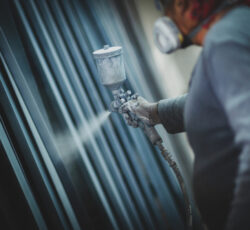 Powder coating is a popular method used to protect metal surfaces from rust and corrosion. It involves applying a dry powder on the metal surface and then curing it with heat to create a durable and protective finish. In this comprehensive guide, we will explore the process of powder coating for rust prevention, its benefits, applications, and best practices.
Powder coating is a popular method used to protect metal surfaces from rust and corrosion. It involves applying a dry powder on the metal surface and then curing it with heat to create a durable and protective finish. In this comprehensive guide, we will explore the process of powder coating for rust prevention, its benefits, applications, and best practices.
What is Powder Coating?
Powder coating is a dry finishing process where a fine powder made of resin, pigment, and other additives is electrostatically sprayed onto a metal surface. The powder adheres to the surface due to the electrostatic charge and is then cured in an oven, where it melts and forms a protective coating. The cured coating is smooth, durable, and resistant to corrosion, chemicals, and UV rays.
Benefits of Powder Coating for Rust Prevention
1. Excellent Durability: Powder coating provides a durable finish that can withstand harsh environmental conditions, making it ideal for rust prevention. The cured coating is resistant to chipping, scratching, and fading, ensuring long-lasting protection for metal surfaces.
2. Corrosion Resistance: One of the primary benefits of powder coating is its excellent resistance to corrosion. The protective coating creates a barrier between the metal surface and the elements, preventing moisture and oxygen from reaching the metal and causing rust.
3. Enhanced Aesthetics: Powder coating is available in a wide range of colors and finishes, allowing you to choose a finish that enhances the appearance of your metal surfaces. The cured coating is smooth, uniform, and attractive, providing a high-quality finish that adds value to your products or equipment.
4. Environmentally Friendly: Powder coating is an environmentally friendly finishing process as it does not contain solvents or volatile organic compounds (VOCs). The powder overspray can be collected and reused, minimizing waste and reducing the environmental impact of the coating process.
5. Cost-Effective: Powder coating is a cost-effective rust prevention solution compared to traditional liquid coatings. The efficiency of the powder coating process, along with its durability and longevity, results in lower maintenance costs and fewer repairs or replacements over time.
Applications of Powder Coating for Rust Prevention
1. Automotive Industry: Powder coating is commonly used in the automotive industry to protect metal parts and components from rust and corrosion. It is used on wheels, chassis, frames, and other metal surfaces to enhance durability and aesthetics.
2. Outdoor Furniture: Powder coating is widely used on outdoor furniture, such as patio tables, chairs, and benches, to protect them from rust and weathering. The durable and weather-resistant finish helps maintain the appearance and integrity of the furniture in outdoor settings.
3. Industrial Equipment: Industrial equipment and machinery are often exposed to harsh conditions that can lead to rust and corrosion. Powder coating is used to protect metal components, machinery parts, and equipment surfaces from corrosion and extend their lifespan.
4. Architectural Applications: Powder coating is employed in architectural applications to protect metal structures, railing, gates, and facades from rust and deterioration. The durable and attractive finish enhances the appearance of architectural elements and ensures long-term protection.
Best Practices for Powder Coating for Rust Prevention
1. Surface Preparation: Proper surface preparation is essential for the success of powder coating. The metal surface should be clean, dry, and free of oil, grease, rust, and contaminants before powder coating is applied. Sandblasting, chemical cleaning, or phosphating can be used to prepare the surface.
2. Correct Application: The powder coating should be applied evenly and in the right thickness to ensure optimal adhesion and protection. The application process should be performed by trained professionals using the appropriate equipment and techniques for consistent results.
3. Curing Process: The curing process is critical for the performance of the powder coating. The coated metal should be cured in an oven at the recommended temperature and duration to achieve a complete cross-linking of the powder particles and form a durable finish.
4. Quality Control: Regular quality control checks should be conducted throughout the powder coating process to ensure adherence to specifications and standards. This includes inspecting the coating thickness, adhesion, appearance, and performance of the finished product.
Summary
Powder coating is a highly effective and versatile method for rust prevention on metal surfaces. Its durability, corrosion resistance, aesthetics, and environmental benefits make it a preferred choice for various industries and applications. By following best practices, such as proper surface preparation, correct application, curing process, and quality control, you can achieve optimal results with powder coating for rust prevention. Consider incorporating powder coating into your rust prevention strategy to protect metal surfaces and prolong their lifespan while enhancing their appearance.
Need a Powder Coating Contractor in Issaquah, WA?
Serving the area since 1997, Powder Vision Inc specializes in residential, commercial, and industrial powder coating restoration on cars and motorcycles, patio furniture, city maintenance, and signage for housing developments! We’ll provide everything you need for a complete and beautiful powder coating project all under one roof, including sandblasting and phosphate wash. Our team has more than 60 years combined of experience! Contact us today to learn more about what we can do for you!
